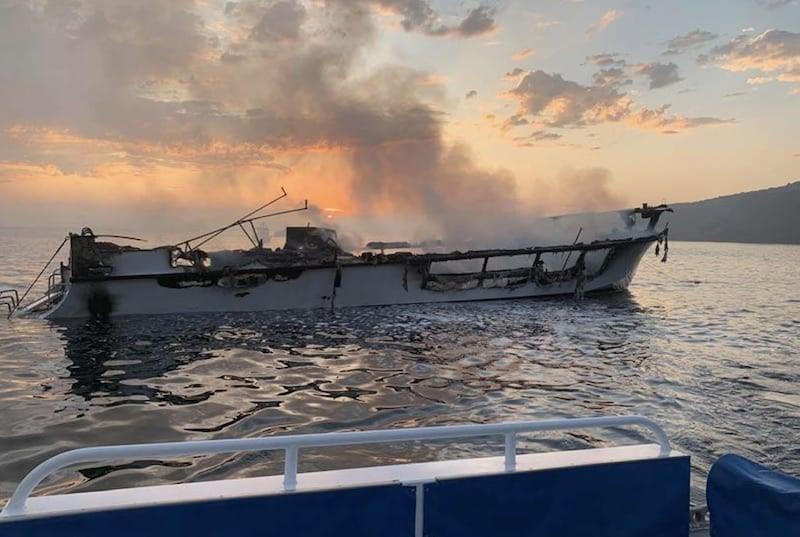While this incident did not occur in Australia, the findings of the National Transportation Safety Board (NTSB) investigation provides our industry with an opportunity to learn from the unfortunate experience of others.
Download and print this safety alert (PDF 355 KB) PDF269.74 KB
The incident
Conception was a 22.8 metre United States flagged passenger vessel that caught fire in the early hours of 2 September 2019. Of the 39 people on board, 34 perished in the incident.
When the fire broke out, the vessel was at anchor off Santa Cruz Island, California.
Five crew members were asleep in the crew berthing area on the upper deck. One crew member and all 33 passengers were asleep in the bunkroom below.
A crew member sleeping in an upper deck berth was awakened by a noise and got up to investigate. Upon seeing a glow outside, he realised that fire was rising up from the saloon compartment directly below, and he immediately alerted the other four crew members sleeping on the upper deck. The master was able to send a distress message to the Coast Guard.
The crew members attempted to access the saloon to assist the passengers and the other crewmember in the bunkroom below the main deck, but access was blocked by fire and thick smoke.
The Coast Guard and other first responder vessels began arriving on scene within 90 minutes but, despite firefighting and search and rescue efforts, the vessel burned to the waterline and sank just after daybreak.

The passenger vessel MV Conception at sunrise prior to sinking, September 2, 2019. (Source: Ventura County Fire Department)
Findings
The NTSB report drew 18 conclusions, the following of which are considered worthy of note by those persons involved in operating passenger vessels in Australia:
- Although a definitive ignition source cannot be determined, the most likely ignition sources include the electrical distribution system of the vessel, unattended batteries being charged, improperly discarded smoking materials, or another undetermined ignition source.
- Although the arrangement of detectors aboard Conception met regulatory requirements, the lack of smoke detectors in the saloon delayed detection and allowed for the growth of the fire, precluded firefighting and evacuation efforts, and directly led to the high number of fatalities in the accident.
- The absence of the required roving patrol on Conception delayed detection and allowed for the growth of the fire, precluded firefighting and evacuation efforts, and directly led to the high number of fatalities in the accident.
- Conception’s bunkroom emergency escape arrangements were inadequate because both means of escape led to the same space, which was obstructed by a well-developed fire.
- Although designed in accordance with the applicable regulations, the effectiveness of Conception’s bunkroom escape hatch as a means of escape was diminished by the location of bunks immediately under the hatch.
- Conception’s operator provided ineffective oversight of its vessels’ operations, which jeopardized the safety of crew members and passengers.
- Had a safety management system been implemented, the operator could have identified unsafe practices and fire risks on the Conception and taken corrective action before the accident occurred.
- Implementing safety management systems on all domestic passenger vessels would further enhance operators’ ability to achieve a higher standard of safety.
While the NTSB investigation did not determine the cause of the fire, the analysis section of the report included the following text which is worth noting.
Since the salon compartment was a critical element in the egress pathway from the passenger bunkroom, prudent fire safety planning would suggest that risky activities (unattended charging of batteries) and materials, such as the plastic chairs and polyethylene trash cans that could contribute to a fire should have been minimized in this area. This was not the case on the Conception.
Crew statements, as well as statements from previous passengers, indicated that the overnight, unattended charging of a large number of batteries was a normal practice in the salon compartment and was a risk that had not been considered. Each device and battery represented a separate potential source of ignition.
The passengers on the Conception were recreational divers, so in addition to common types of electronic items, such as phones, tablets, digital cameras, and laptops, divers also used underwater cameras, flashes, strobes, and flashlights.
AMSA will consider the NTSB report in full when reviewing the current regulatory requirements for domestic commercial vessels, including the standards for fire safety and accommodation and arrangement.
Reminder
- Review your risk-assessment for your operation regularly, and update your safety management system as required.
- Consider emergency escape options for your vessel.
- Consider watch arrangements on your vessel, including the use of a roving watch during sleep periods.
- Ensure that smoke and fire detection systems on your vessel are suitable, allow for proper coverage and are properly maintained.
- Consider whether your vessel’s electrical systems are capable of dealing with the safe simultaneous charging of large numbers of personal electronic devices such as mobile phones, tablets and computers, all of which utilise lithium ion batteries.
Further reading
- NTSB report synopsis - Fire Aboard Small Passenger Vessel Conception, Platts Harbor, Channel Islands National Park, Santa Cruz Island, 21.5 miles South-Southwest of Santa Barbara, California September 2, 2019 DCA19MM047
- AMSA Safety alert 05/2020 – Fire prevention and protection
- WA Department of Mines, Industry Regulation and Safety – Lithium-Ion Battery Safety